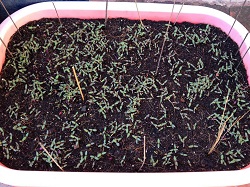How to Amaranthus?
Amaranthus Overview
Amaranthus, that is grown as a grain crop. It’s not a kind of grass as most grains are, but amaranth is grouped together with the other grains anyway. Amaranth seeds are very high in protein, and its a very high-quality protein closer to what you find in soybeans.
The amaranthus family includes flowers, herbs, and weeds. Some varieties are grown and harvested for food.
This document focuses on growing Amaranthus.
Table 1 Planting Guide
|
Depth to plant |
0.25 inches deep |
|
Spacing between seeds |
Space seeds about 7'' to 10'' apart (tolerates crowding) |
|
Spacing between seedlings |
Space seedlings about 10'' to 12'' apart (tolerates crowding) |
|
Days to germinate (Sprout) |
4-8 days |
|
Planting season |
Annual |
|
Plant height |
Approx 5 ft tall |
|
Soil requirement |
Prefers soil rich in Nitrogen and Phosphorous |
Amaranthus Prerequisites
- Light: Full sun
- Water: When it comes to watering amaranthus in container gardens, water only when dry
Amaranthus Growing Steps
The following steps define the process of growing Amaranthus from seed to harvest.
1. You must directly sow the seeds of amaranthus from MyGreenVault into containers. For more information on sowing tips, refer to ***.

2. A week after the seeds germinate, you can move you container to direct sunlight.

Note: Wet conditions do not promote seed germination in case of this plant and even if the seedlings emerge, most probably they will decay.
3. Prepare a good growing medium. A good, simple option is a mix of two parts potting soil, one part Coco Peat (CP) and one part Vermi Compost (VC). The soil and VC provides your plant with the nutrients it needs, while the CP mix retains the moisture.

Amaranthus Plant Maintenance
Amaranthus require evenly moist soil to ensure the best and fast growth. Do not over
water or allow the soil to dry out.
- Amaranthus are non-fussy greens. Ensuring adequate sun, along with intermittent Compost Tea (CT) foliar spray does wonders.
Note: For more information on CT preparation and application, refer to ***. - Once the soil has warmed, mulch around to retain soil moisture and an even growing temperature.
Amaranthus Companion Plants
Bush beans and other nitrogen-fixing crops.
Amaranthus Plant Protection
Amaranthus Pests
Amaranthus can be attacked by the following:
- Ants
- Leat eating caterpiller
Amaranthus Diseases
The following diseases are known to commonly afflict White Long Brinjal Plant
- Leaf Spot
- Root Decay
Amaranthus Organic Control
Once you have identified the troublemakers, you can control them with an assortment of organic pest-control methods. The following list contains few methods:
a. Ants
- Lemon juice or chilli garlic spray
Note: For more information on preparation and application of lemon juice and chilli garlic spray, refer to ***.
b. Leaf eating caterpiller
- Hand pick off the plants
- Dislodge with jet water spray
c. Leaf spot
- Remove the affected plants in the early stages to control the vector
d. Root decay
- If the soil is too damp and soggy, you will have to stop watering for a couple of days and replace the top soil. Ensure that the container has ample holes for proper water drainage. Also, moving the container to bright sunlight helps.
Amaranthus Harvesting
Your organic colorful amaranthus greens are ready for harvest before they start flowering.

Note: You can also cut your amaranthus when it is between one and two feet tall. You must cut the whole stem, maybe six to ten inches above the ground. The stem will re-shoot and can be harvested again.
The time from planting to harvest is 20 to 30 days from seed. Finally, the hard work pays off and you have the most colorful and sweet smelling greens!

